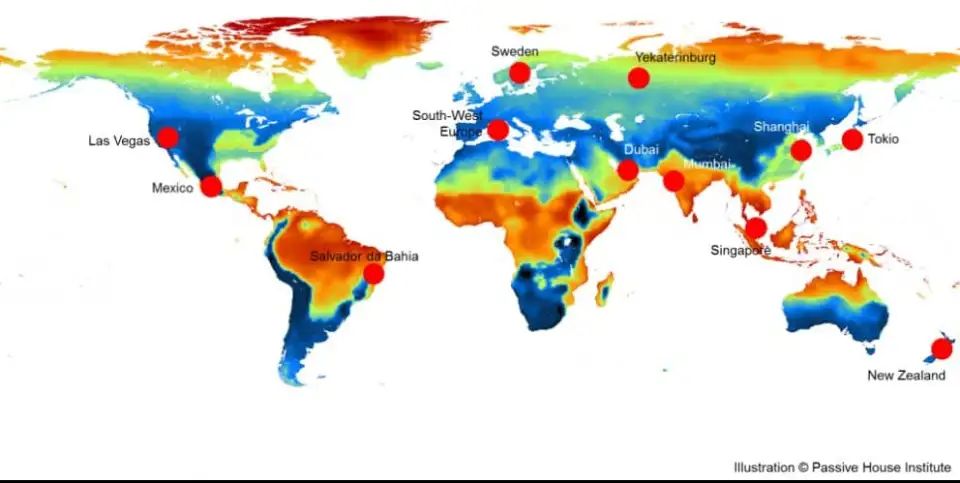
Searching in the Passive House Database, you can find around 4806 Passive House Buildings while it is estimated that there are more than 120.000 around the world, most of them calculated using the Passive House Planning Package (PHPP).
During the last semester, two important studies were published regarding the Passive House concept. The first is a paper written by Jürgen Schnieders—along with other scientists—about the implementation of the Passive House concept in different climate zones. The paper called “Design and realisation of the Passive House concept in different climate zones” was published by Springer on September 2nd.
The paper briefly introduces the Passive House design principles and criteria. Then, nine examples of Passive Houses in climates of Canada, the USA, Germany, China, Greece, Spain, Taiwan, Mexico and the United Arab Emirates illustrate the bandwidth of possible solutions. For many projects, practical experience is available, which typically reveals high user satisfaction and energy consumption close to what would be expected based on the design calculations.
The Reimagine Buildings Collective brings together building professionals stepping up to tackle climate change.
The progress of the Passive House community is huge. Passive House started as a concept that was implemented only in Germany or in regions with similar climate conditions and now, officially, it can be adopted anywhere in the world. Furthermore, it is the only building concept for which the same training material and designing tools are used all over the world.
Today, this concept is clearly defined, with validity for all climates worldwide. Under cold climate conditions, the design process typically is focused on minimising heat losses and optimising solar gains. In milder climates, moderate insulation, including windows with improved performance, is sufficient, though building performance during summer requires more careful consideration. For hotter climates, the insulation requirements increase again, and solar loads through windows, walls and roofs must be limited. In hot and humid climates, humidity loads need to be minimised or reduced. In practical implementation, every Passive House has its own, specific boundary conditions which lead to different building components and techniques to fulfill the stringent requirements of the Passive House standard.
According to the 2nd important study, this paper earns more credibility. This is the “PHPP V9.6 Validation using ANSI/ASHRAE Standard 140‑2017” prepared by Remi Sharron published on January 23rd.
Passive House Canada, Passive House California, New York Passive House and the Passive House Institute contracted Remi Charron Consulting Services, to test PHPP Version 9.6 using ANSI/ASHRAE Standard 140 in order to give more building officials the authority to accept PHPP as an energy model for building code energy performance compliance. The project objectives were to:
Evaluate PHPP using the ASHRAE Standard 140‑2017 test cases and to record the results
Examine and comment on PHPP’s predictions in comparison to benchmarks provided in Standard 140 and suggest the causes of observed differences and
Document findings in a comprehensive report
The validation tests consist of a series of carefully described sample case building plans. Results from modeling different test cases with the software that is being tested are compared to those of reference software results. The class II test cases, geared towards annual building energy use, comprise a total of 38 test cases, 21 for heating and 17 for cooling.
It has been proven that the PHPP offers the possibility to accurately predict the energy use of buildings in many post-occupancy studies. Good agreement with other building simulation programs was also found earlier. The new results support this general experience following the formal test procedure of ANSI/ASHRAE 140. It must be mentioned that the Passive House Planning Package (PHPP) v.9, or newer, has been formally approved for use under the 2018 Building Code for the Canadian Province of British Columbia.
The Passive House concept and PHPP can officially be adopted/used everywhere in the world!